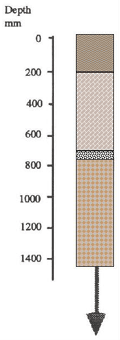Langwarrin sand
Symbol: Las
Geology - Silurian sediments or on material derived from these sediments covered by a thin layer (less than 1 m) of aeolian sand similar to Cranbourne sand.
Landform - Rolling low hills.
Soils
These soils are similar to Bittern sand. However, they differ in that the underlying rocks are Silurian sediments rather than Tertiary sandstone.
The surface soils of Langwarrin sand are grey or dark grey loamy sands or sandy loams about 250 mm deep, overlying a bleached layer of similar texture. Concretions of iron oxide may occur at the bottom of this layer. Mottled light grey and yellowish brown medium clays occur from about 700 mm and continue to at least 1500 mm. Decomposing Silurian sediments occur in the deep subsoil.
Typical profile of Langwarrin sand
 | 0 - 250 mm. Grey or dark brownish grey sandy loam to loamy sand. Clear transition to: 250 - 700 mm. Pale grey to pale brownish grey sandy loam to loamy sand. Concretions of ironstone gravel are common at the bottom of this layer. Sharp transition to: 700 mm - 1.4 m. Mottled light grey and yellowish brown medium clay. |
These soils are mainly used for pasture for beef and dairy cattle. Because they have a similar surface soil to Cranbourne sand they are often cultivated for horticulture (mainly vegetables). However, the soil becomes saturated with water during the wetter months because of the clay in the deep subsoil. Sub-surface drainage is required if vegetables are to be grown throughout the year.


